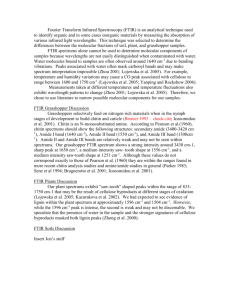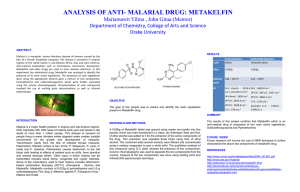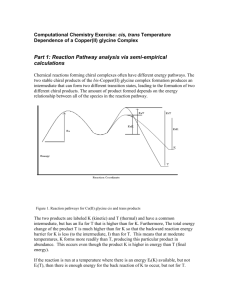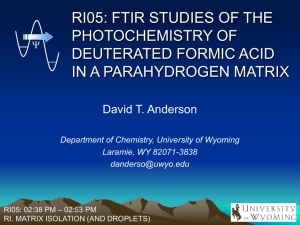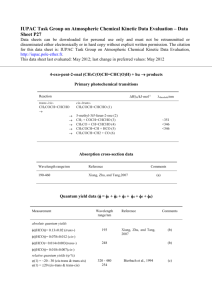SupplimentrayMaterial_Revised
advertisement
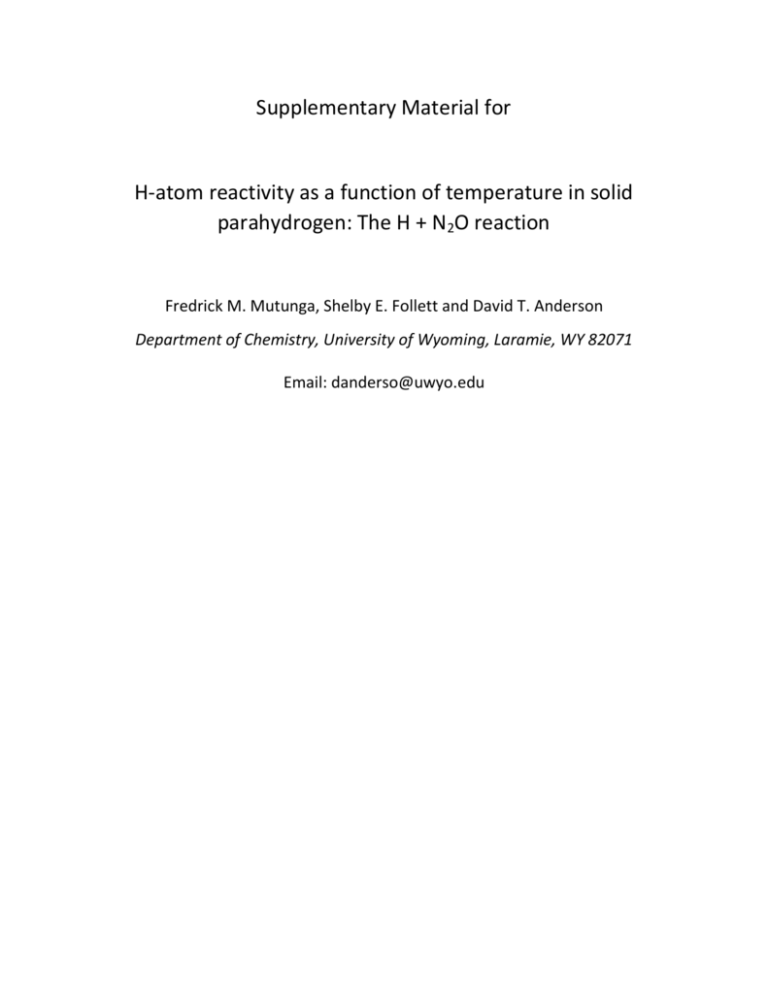
Supplementary Material for H-atom reactivity as a function of temperature in solid parahydrogen: The H + N2O reaction Fredrick M. Mutunga, Shelby E. Follett and David T. Anderson Department of Chemistry, University of Wyoming, Laramie, WY 82071 Email: danderso@uwyo.edu 1. Experimental details The N2O doped pH2 crystals are prepared using the rapid vapor deposition method of Fajardo and Tam.1, 2 The crystal is grown by co-deposition of independent gas flows of 15N218O and pH2 onto a pre-cooled BaF2 optical substrate held at ~2.5 K within a sample-in-vacuum liquid-He cryostat. We estimate the N2O dopant concentrations based on the measured flow rates of dopant and pH2 gas into the cryostat during deposition. For these studies the dopant concentration ranged from 20 to 70 ppm. The pH2 solids are prepared by enriching normal-H2 gas to greater than 99.97% pH2 enrichment levels using a variable temperature ortho/para converter operated near 14.0 K. The orthohydrogen (oH2) concentration in the sample can be checked using the integrated intensity of the oH2-induced Q1(0) feature1 and the measured crystal thickness.3 The temperature of the sample is measured using two Si-diode sensors; one is mounted (TA) to the cold tip of the helium cryostat and the other (T B) is mounted to the Auplated oxygen-free-high-conductivity Cu substrate holder at the point furthest from the cold tip. All the reported temperatures are using TB. The H-atoms are generated as by-products in the 193 nm in situ photolysis of the 15N 18O 2 precursor. The unfocused 193 nm output of a broadband ArF excimer laser (Gam Laser EX5) with 8 ns pulse duration is directed at an angle of 45° with respect to the surface normal of the BaF2 optical substrate. The FTIR beam is focused with 8″ off-axis parabolic mirrors through the sample at normal incidence to the BaF2 optical substrate in a transmission optical setup. This optical setup permits FTIR spectra to be recorded within the photolysis region either during or immediately after 193 nm irradiation. The laser fluences in these experiments, measured with a power meter after an adjustable iris located in front of the photolysis window on the cryostat, range from 60 to 75 J cm-2 pulse-1 and we used the highest 250 Hz repetition rate of the laser. High-resolution rapid scan FTIR spectroscopy (e.g., acquisitions times of 290 sec for 16 co-added scans at 0.03 cm-1 resolution) is performed on the sample using a FTIR spectrometer (Bruker IFS 120HR) equipped with a glowbar source and Ge-coated KBr beamsplitter. For all the kinetic measurements we use a liquid nitrogen cooled HgCdTe detector to record spectra from 700 to 4500 cm-1. The concentration of the cis and trans isomers of H15N15N18O are measured from the integrated intensity of the 2 (NN stretch) absorptions near 1575 cm-1 using the following integration protocols. The cis peak is integrated from 1573.5 to 1576.5 cm-1 and the trans peak from 1577.5 to 1580.5 cm-1. We calculate the concentration in units of parts per million (ppm) using the following equation, [X] 2.303 log 10 ( I / I 0 )d~ l V0 (1x10 6 ) (1) where X is cis or trans, is the integrated absorption coefficient, l is the IR pathlength through the crystal, and V0 is the molar volume4 of solid pH2 at liquid helium temperatures (23.16 cm3 mol-1). The value of l is determined for each sample using the IR spectroscopic method developed by Fajardo.3 The values used are 367.3 and 240.2 km mol-1 for the cis and trans 2 modes, respectively. Note these values are for the H15N15N18O isotopomer and were provided to us by Professor Kirk A. Peterson.5 2. Spectroscopic results We made the cis- and trans-H15N15N18O spectroscopic assignments based on the agreement with the peak positions of Xe matrix isolation results6, 7 and full anharmonic calculations of the vibrational frequencies and isotopic shifts.8 The measured peak positions and isotopic shifts are presented in Tables S1 and S2. We tested these assignments using binary intensity correlation plots which are shown in Figures S1 and S1. These correlation plots demonstrate that there are two distinct product species and that the peak assignments to a given isomer are internally consistent. Shown in Figure S3 is a series of IR spectra recorded during the course of a single photolysis experiment on a 15N218O doped pH2 solid conducted at 1.81(2) K showing the corresponding cis- and trans-H15N15N18O peaks used to monitor the chemistry. We chose to use the 2 mode (NN stretch) to monitor the concentration of cis- and trans-H15N15N18O. Trace (a) in Figure S3 is recorded prior to photolysis and shows no discernible IR absorptions in this small window between 1570 and 1585 cm -1. Trace (b) is recorded beginning immediately after the 10 minute photolysis of the sample at 1.84 K and shows a small peak at 1574.91 cm-1 due to the slight production of cis during low temperature photolysis. Trace (c) is recorded 486.4 minutes after trace (b) while maintaining the sample at a constant temperature of 1.81(2) K. Clearly there is significant growth in the intensity of the two peaks corresponding to cis- and trans-H15N15N18O. We use the integrated intensity of these two peaks combined with the measured thickness of the sample to calculate the concentration of both isomers. Note that the FTIR spectra shown in Figure S3 are for the experiment displayed in Figure 1. Table S1. Measured peak positions and isotopic shifts () all in cm-1 for cis-HNNO. mode 1 NH str 2 NN str 3 NO str 4 HNN bend a 14N 16O/Xea 2 14N 16O/pH 2 2 15N 18O/pH 2 2 (Expt.) 3158 1623.7 1273.4 1166.9 3069.08 1629.28 1282.48 1574.91 1255.31 -54.37 -27.17 (Calc.)b -6.7 -55.4 -26.5 -40.0 In a Xe matrix, Ref. 7. Calculated isotopic shift, Ref. 8. b Table S2. Measured peak positions and isotopic shifts () all in cm-1 for trans-HNNO. mode 1 NH str 2 NN str 3 NO str 4 HNN bend a 14N 16O/Xea 2 14N 16O/pH 2 2 15N 18O/pH 2 2 3254.0 1628.9 1294.5 1213.4 3280.29 1634.52 1299.19 1221.27 3273.17 1578.82 1272.26 1186.91 In a Xe matrix, Ref. 7. Calculated isotopic shift, Ref. 8. b (Expt.) -7.12 -55.70 -26.93 -34.36 (Calc.)b -7.1 -57.8 -35.3 -31.1 0.07 cis integrated intensity / cm-1 0.06 0.05 3 NO stretch 0.04 0.03 0.02 0.01 0.00 0.00 0.02 0.04 0.06 0.08 0.10 0.12 0.14 cis 2 NN stretch integrated intensity / cm-1 Figure S1. Binary intensity correlation plot for cis-H15N15N18O. 0.20 integrated intensity / cm-1 trans 0.15 3 NO stretch 0.10 cis-N-N vs cisv3 cis-N-N vs cisv3 cis-N-N vs cisv3 4 HNN bend 0.05 0.00 0.00 0.02 0.04 0.06 0.08 0.10 0.12 trans 2 NN stretch integrated intensity / cm -1 Figure S2. Binary intensity correlation plot for trans-H15N15N18O. 0.14 0.5 trans log10(I0/I) / abs 0.4 cis 0.3 0.2 0.1 0.0 (c) (b) (a) 1570 1575 1580 1585 wavenumber / cm -1 Figure S3. Representative IR spectra displaying the 2 (NN stretch) peaks of cis- and transH15N15N18O at various steps in a low temperature reaction study on a 0.24(2) cm thick, 23 ppm 15N 18O doped pH sample. Trace (a) is recorded at 1.82 K before photolysis, trace (b) is 2 2 recorded (16 co-added scans, 290 sec, 0.03 cm-1 resolution) at 1.83 K right after photolysis, and trace (c) is recorded 486.4 min after trace (b) while the sample is maintained at a constant temperature of 1.81(2) K. Table S3. Kinetic parameters determined from fit to data in Figure 1. parameter A10 / ppm A20 / ppm k1 /10-3 min-1 k2 /10-3 min-1 R2 a cisa 6.01(24)(28) 0.0440(28) 1.413(46) 8.63(18) 0.999162 transb 2.60(22) 0.000(8) 1.67(22) 12.1(27) 0.999773 cis function: f (t ) A20 exp( k 2t ) k1 A10 exp( k 2t ) exp( k1t ) k1 k 2 1 trans function: f (t ) A10 1 exp( k1t ) exp( k1t ) exp( k2t ) A20 1 exp( k2t ) . k k 2 1 b k REFERENCES [1] S. Tam, and M. E. Fajardo, Rev. Sci. Instrum. 70, 1926 (1999). [2] S. Tam, and M. E. Fajardo, Appl. Spectrosc. 55, 1634 (2001). [3] M. E. Fajardo, in Physics and Chemistry at Low Temperatures, edited by L. Khriachtchev (Pan Stanford Publishing Pte. Ltd., Singapore, 2011), pp. 167. [4] I. F. Silvera, Rev. Mod. Phys. 52, 393 (1980). [5] K. A. Peterson, (private communication, 2012). [6] K. M.-R. Isokoski, in Ph.D. Thesis (University of Helsinki, Helsinki, 2008), p. 69. [7] S. L. Laursen, A. E. Delia, and K. Mitchell, J. Phys. Chem. A 104, 3681 (2000). [8] K. A. Peterson, and J. S. Francisco, J. Chem. Phys. 134, 084308 (2011).
